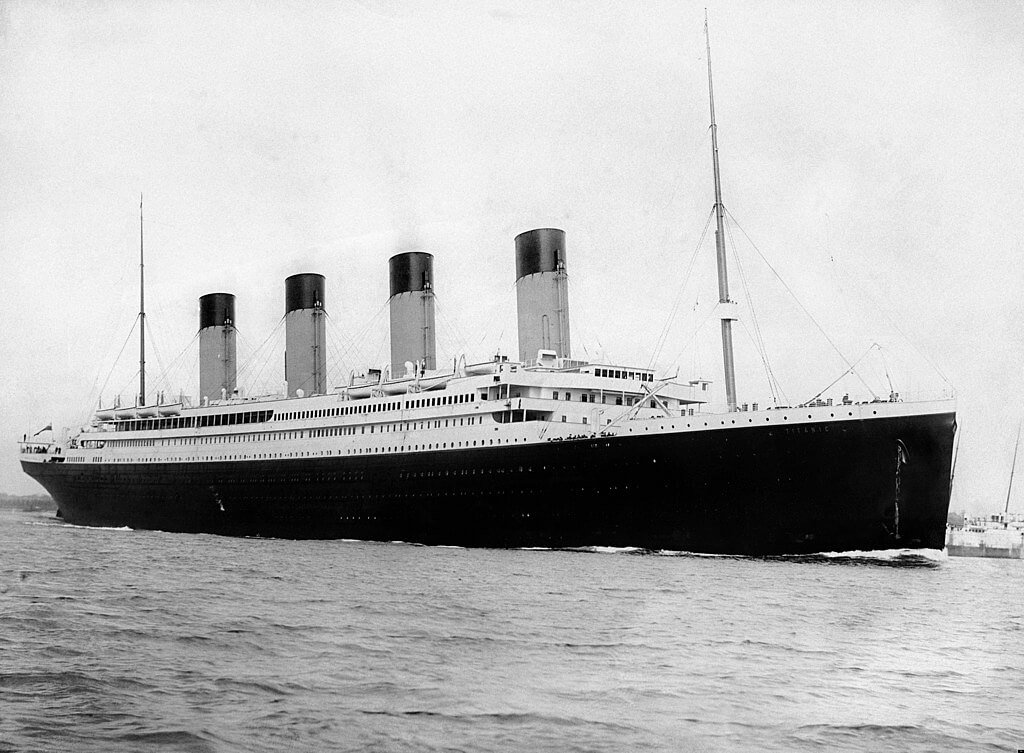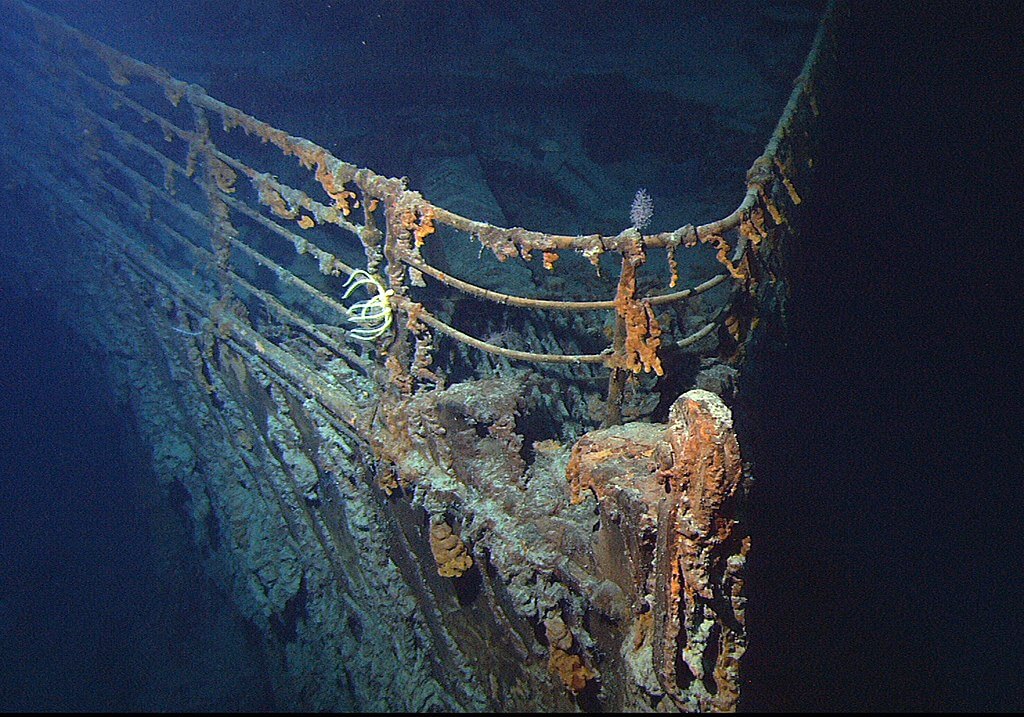Learn about the history, features, sinking, and fascinating facts of the Titanic. Discover the story of the ill-fated ship and its tragic end on its maiden voyage from Southampton to New York City.

Source: wikipedia.org
Titanic; Shortly before midnight on April 14, 1912, the 46,328-ton White Star liner Titanic, on her maiden voyage from Southampton to New York, collided with an iceberg off the Banks of Newfoundland. The night was clear, but apparently there was some surface haze. Two hours and forty minutes after the impact, the magnificent new liner—the pride of the British merchant service, the largest and most sumptuously appointed vessel which had ever put to sea—went down with a loss of more than 1,500 lives.
The root cause of this appalling catastrophe, which was accounted at the time “the most terrible shipwreck in history,” was simply bad seamanship. Despite all the urgent warnings of ice, by radio and signal-lamp, the Titanic, in hopes of an early arrival in New York harbor, continually increased speed and drove that night into the ice track at over 22 1/2 knots (41.7 km/hr).
The Californian, the only vessel in the vicinity, lay on the edge of the icefield with her engines stopped, made no attempt to reach the wreck: though rocket after rocket was clearly seen from her bridge. Her radio operator had gone off duty. The Cunard Carpathia, however, on receiving the Titanic s distress call, at once turned round and steamed at high speed through the ice to the rescue of the survivors.
It is to be observed that though the White Star Line was absolved at the British inquiry, in the High Court—and subsequently on appeal— the charge of negligence was upheld, and the company was ordered to pay heavy damages to the relatives of several of those lost.
Some safety measures prompted by the wreck were creation of the International Ice Patrol, provision of lifeboat space for all persons on a ship, and constant radio watch at sea.
History of Titanic (Ship)
The Titanic was a British passenger liner that was launched in 1911 and famously sank on its maiden voyage in 1912. The ship was designed to be the largest and most luxurious ocean liner of its time, and was considered to be “unsinkable” due to its advanced technology and safety features.
The Titanic was built by the White Star Line at the Harland and Wolff shipyard in Belfast, Northern Ireland. It was over 880 feet long and weighed over 46,000 tons, making it the largest ship of its time. The ship featured first-class accommodations that included grand staircases, a swimming pool, a gymnasium, and luxurious cabins.
On April 10, 1912, the Titanic set sail from Southampton, England, on its maiden voyage to New York City. On the night of April 14, the ship struck an iceberg in the North Atlantic Ocean and began to sink. Despite the advanced technology and safety features, the ship did not have enough lifeboats for all of the passengers and crew on board, and many perished in the freezing water.
The sinking of the Titanic was one of the deadliest maritime disasters in history, with over 1,500 people losing their lives. The tragedy had a profound impact on the world and led to significant changes in maritime safety regulations.
In the years since the sinking of the Titanic, there have been numerous expeditions to the wreckage site, which lies over two miles below the surface of the ocean. The story of the Titanic has also been immortalized in books, films, and popular culture, cementing its place as one of the most iconic ships in history.

Source: wikipedia.org
Features
The Titanic was designed to be the largest and most luxurious ocean liner of its time, and it featured many innovative and impressive features. Here are some of the notable features of the Titanic:
- Grand Staircase: The Titanic featured a grand staircase made of oak and wrought iron, which was designed to be a central feature of the ship’s interior. The staircase was decorated with luxurious details such as bronze cherubs and oak paneling.
- First-Class Accommodations: The first-class accommodations on the Titanic were the height of luxury, with spacious cabins, private bathrooms, and elegant furnishings. The ship also featured a swimming pool, a gymnasium, a squash court, and a Turkish bath.
- Second-Class Accommodations: The second-class accommodations were also comfortable and spacious, with cabins that could accommodate two to four passengers. The passengers in second class had access to a library and a smoking room.
- Third-Class Accommodations: The third-class accommodations were more basic, with shared sleeping quarters and communal bathrooms. However, the passengers in third class still enjoyed a high standard of comfort compared to other ships of the time.
- Advanced Technology: The Titanic was equipped with the latest technology of its time, including a wireless communication system, electric elevators, and a sophisticated navigation system.
- Lifeboats: The Titanic had a total of 20 lifeboats on board, which could accommodate around 1,200 people. However, this was not enough to save all of the passengers and crew in the event of an emergency.
- Promenade Deck: The Titanic had a promenade deck that wrapped around the ship, allowing passengers to take in the sea air and enjoy the views.
Overall, the Titanic was a masterpiece of engineering and design, and it set a new standard for luxury ocean travel.
What happened to the ship Titanic?
The Titanic famously sank on its maiden voyage from Southampton, England to New York City on the night of April 14, 1912. The ship struck an iceberg in the North Atlantic Ocean and began taking on water. Despite the advanced technology and safety features of the ship, it was not able to stay afloat and eventually sank in the early hours of April 15.
The sinking of the Titanic was a tragic event that resulted in the loss of over 1,500 lives, including passengers and crew. The ship did not have enough lifeboats for all of the passengers and crew on board, and many people perished in the freezing water.
The sinking of the Titanic had a profound impact on the world and led to significant changes in maritime safety regulations. The tragedy also became a cultural touchstone and has been the subject of numerous books, films, and other works of art. In recent years, there have been many expeditions to the wreckage site of the Titanic, which lies over two miles below the surface of the ocean.

The bow of the wrecked Titanic, photographed in June 2004 (Source : wikipedia.org)
Facts About Titanic
Here are some interesting facts about the Titanic:
- The Titanic was one of three sister ships built by the White Star Line, along with the Olympic and the Britannic.
- The Titanic was the largest ship of its time, measuring 882 feet long and weighing over 46,000 tons.
- The ship featured first-class accommodations that included a grand staircase, a swimming pool, a gymnasium, and luxurious cabins.
- The Titanic set sail from Southampton, England on its maiden voyage to New York City on April 10, 1912.
- The ship struck an iceberg in the North Atlantic Ocean on the night of April 14, 1912 and sank in the early hours of April 15.
- The Titanic did not have enough lifeboats for all of the passengers and crew on board, and over 1,500 people lost their lives in the tragedy.
- The disaster had a profound impact on the world and led to significant changes in maritime safety regulations.
- The Titanic was discovered by a team of scientists led by Dr. Robert Ballard in 1985, over 70 years after it sank.
- The story of the Titanic has been immortalized in books, films, and popular culture, making it one of the most iconic ships in history.
Despite its reputation as an “unsinkable” ship, the Titanic was not designed to withstand the impact of an iceberg and lacked the necessary safety features to prevent a disaster.